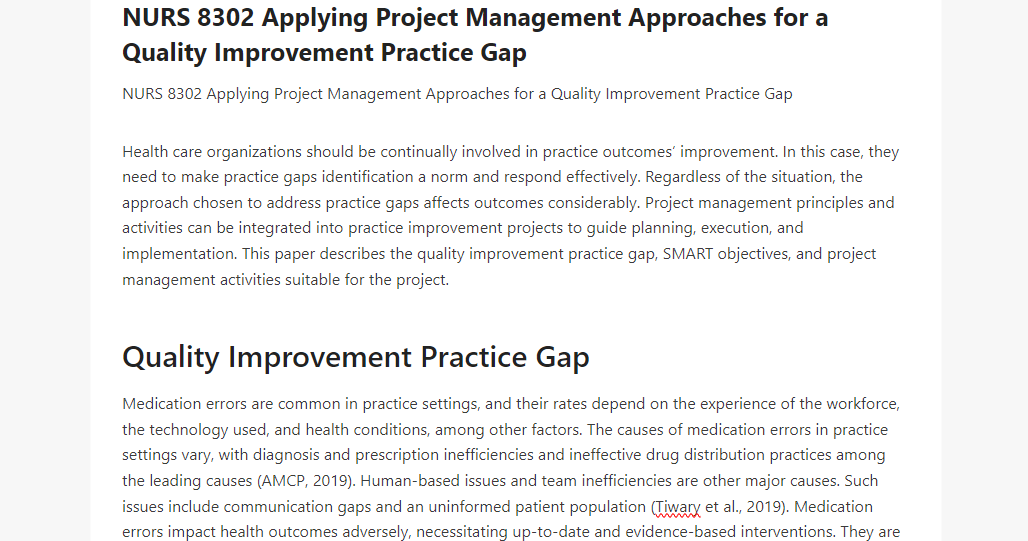NURS 8302 Assignment 1 Applying Project Management Approaches for a Quality Improvement Practice Gap
NURS 8302 Applying Project Management Approaches for a Quality Improvement Practice Gap
Health care organizations should be continually involved in practice outcomes’ improvement. In this case, they need to make practice gaps identification a norm and respond effectively. Regardless of the situation, the approach chosen to address practice gaps affects outcomes considerably. Project management principles and activities can be integrated into practice improvement projects to guide planning, execution, and implementation. This paper describes the quality improvement practice gap, SMART objectives, and project management activities suitable for the project.
Quality Improvement Practice Gap
Medication errors are common in practice settings, and their rates depend on the experience of the workforce, the technology used, and health conditions, among other factors. The causes of medication errors in practice settings vary, with diagnosis and prescription inefficiencies and ineffective drug distribution practices among the leading causes (AMCP, 2019). Human-based issues and team inefficiencies are other major causes. Such issues include communication gaps and an uninformed patient population (Tiwary et al., 2019). Medication errors impact health outcomes adversely, necessitating up-to-date and evidence-based interventions. They are sources of new health conditions, injuries, and even death (Wondmieneh et al., 2020). Medication errors also cause patient dissatisfaction by reducing the quality of overall care.
Click here to ORDER an A++ paper from our Verified MASTERS and DOCTORATE WRITERS NURS 8302 Applying Project Management Approaches for a Quality Improvement Practice Gap:
Health care organizations can apply different strategies in medication errors control. These strategies can be the basis for using project management activities in practice improvement. Modern technology integration into health care practices is highly recommended in reducing and preventing medication errors. For instance, as Godshall and Riehl (2018) proposed, barcode scanning can prevent and mitigate drug prescription and administration problems. The other strategy is creating an informed nursing staff through nursing education. Doing so can help nurses follow institutional policies on medication transcription, such as the five rights of medication (Hanson & Haddad, 2021). Individually or jointly, these strategies can effectively address the practice gap.

NURS 8302 Applying Project Management Approaches for a Quality Improvement Practice Gap
SMART Goals
Medication errors cannot be effectively addressed without setting goals to guide practice improvement. Suitable goals in the planning phase or execution phase include:
- Adopting appropriate technologies in the practice setting to prevent medication errors within six months.
- Educating the nursing staff to equip it with knowledge on medication errors prevention and control in three months.
As required in goal setting, these goals are specific, measurable, and time-bound. They outline the measures necessary to achieve a particular outcome.
Project Management Activities to Apply in the Project
Project management is a broad topic with different phases and activities. A suitable project management activity for the project is a project strategy and business case. In project management, project strategy and the business case involve defining all the project’s requirements and proposing an appropriate methodology to achieve the desired goals (Schmidt, 2021). In medication errors’ prevention, project strategy and business case would involve identifying the technologies needed to prevent errors and proposing an approach to acquire them. For instance, the practice setting can rely on internal resources or donations.
The other crucial activity is preparation. It is a critical activity before the project starts. Here, the project leader ensures that all the necessary resources are in place and timelines and roles are defined through work breakdown structure and Gantt charts, among other tools. Both activities are crucial to prevent working on a project without a definite end and specific goals.
Conclusion
Quality improvement requires high-level thinkin
Order this paper